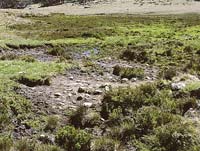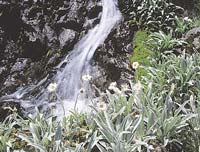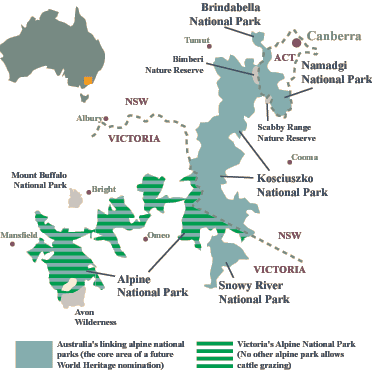 |
Cattle trampling fire-affected grassland (HW)
|
 |
Trampled and drained peat bog, Buckety Plain (PI)
|
 |
|
Bank erosion and siltation, Cape Creek (HW)
|
 |
|
The Silky Daisy Celmisia sericophylla, is one of several Victorian alpine plants at grave risk of extinction. (CT)
|
A few points to consider...
Grazing spreads weeds.
Licenced cattle grazing has been responsible for dramatically increasing the spread of English Broom through the Alpine National Park, and many other weeds which can vigorously outcompete native alpine species.
Cattle grazing is also likely to greatly encourage the spread of new alpine weeds, such as the dreaded Orange Hawkweed.
Grazing does not reduce the fire risk in Victoria’s Alps. In fact, grazing has been implicated for years in the spread of flammable shrubs in much of the park.
“...a decision regarding cattle grazing in the High Country should not be based on the argument that ‘grazing prevents blazing’.”
- Report of the Inquiry into the 2000-2003 Victorian Bushfires, State Goverment of Victoria. Cows and Fire...
Ancient peat beds damaged.
Cattle trample fragile peaty soils, causing channels to form. This leads to rapid runoff, and erosion of moss-beds, bogs and stream banks. Alpine peat bogs and mossbeds are a prime source of high quality water in the alps. As it is, it will take a great many years for these systems to recover from grazing. Cattle and Peat Beds...
The economics don’t stack up.
Mountain cattlemen are paying $5.50 a head for around 4 months grazing over summer (many farmers pay that for a week’s agistment). The Government’s income from these grazing licences totals around $30-40,000 a year, but it costs the taxpayer at least $600,000 a year to ‘manage’ alpine grazing.
Alpine streams and rivers damaged.
Increased siltation and nutrient loads in streams affect rivers and dams downstream, and cause many changes in underwater life. The introduction of pathogens to waterways can cause health problems for park visitors, and for other water users downstream.
The cultural claim...
Increasingly, cattle are being trucked to the High Country and left unattended most of the summer, where they wander blissfully far beyond licence boundaries. Some of the licences are now in the hands of companies which capitalise on the legend to hang on to their cheap agistment ‘rights’.
There are much better ways (such as special events, tours and cultural heritage centres) to respect Victoria’s mountain traditions than propping up an ecologically damaging farming practice.
Note: Most bush grazing licences in the area are outside of the National Park.
Grazing threatens many plants and animals with extinction.
The park’s plants and animals are facing many threats, including the very big one of global warming.
Grazing and trampling by cattle add greatly to these threats.
At least 15 plants and animals, and several vegetation communities, are listed under Victoria’s Flora and Fauna Guarantee Act as being at risk from cattle grazing in the alps, and a further 30 plants in grazing licence areas are listed as vulnerable. Threatened Species...
More than 50 years of scientific studies and reports consistently show that grazing has no place in Victoria’s Alpine National Park.
“That grazing under licence (in the alps) has persisted in Victoria to the present is an indictment of Victoria’s land management authorities...who have failed to take into account the scientific evidence available, and give it its due in the politics of making decisions on land management.”
- From a ‘Grazing in the Victorian High Country: a Report to Parks Victoria” by Dr Richard Groves, Senior Principal Research Scientist, Division of Plant Industry, CSIRO. (more...)
|
 Time to look after the alps...
Time to look after the alps...



